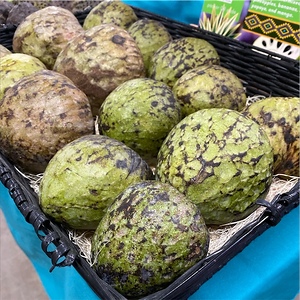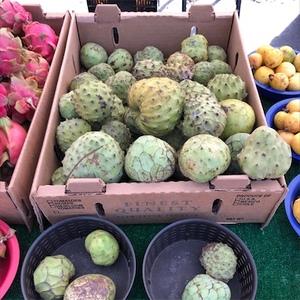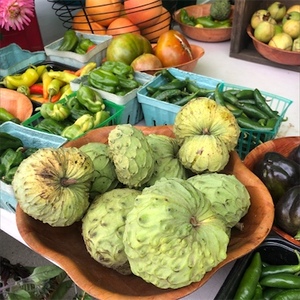


Green Custard Apples
Estimated Inventory, lb : 0
This item was last sold on : 04/04/24
Description/Taste
Green Custard apples vary in size and shape, depending on the specific variety and growing environment, and average 8 to 16 centimeters in diameter. The fruits also range in shape from round, cordate to oblate and sometimes have an irregular, lopsided nature. Green Custard apples are attached to the tree by thick, woody, and fibrous stems, and when ripe, the stems and core can be cleanly pulled from the flesh. The skin is semi-smooth, taut, and thin but tough, showcasing flat, scale-like designs or a reticulated netted appearance. The surface also ripens from green to lighter shades of yellow-green when ripe, sometimes with brown tones. Underneath the surface, the dense, granular flesh is moist, creamy, soft, and tender with a melting consistency. The flesh is found in white and ivory tones, enveloping a central fibrous core that tapers through the fruit. Some varieties also contain many black-brown, glossy, smooth seeds, with some fruits bearing as many as seventy seeds. Green Custard apples develop a delicate, squishy feel, often feeling like a heavy water balloon when ripe. The coloring may also change slightly when mature, but not all varieties have a noticeable color change. The flesh releases a perfumed aroma and is edible raw when ripe. Green Custard apples have a mild, sweet, and slightly acidic taste with tropical undertones reminiscent of pineapples, strawberries, and lemons.
Seasons/Availability
Green Custard apples are available year-round in tropical climates, with a peak season in the early winter through late spring.
Current Facts
Green Custard apples, botanically classified as Annona reticulata, are tropical fruits belonging to the Annonaceae family. The fruits grow on deciduous trees reaching 4 to 12 meters in height and are a species favored as a fresh-eating culinary ingredient. It is important to note the name Custard apple is a broad term often used for several species of the Annona genus that vary in appearance and flavor. This makes it challenging to distinguish between the fruits of each species. For the purposes of this article, most experts attribute the name Custard apple to the species Annona reticulata. Several varieties are generally classified under the name Green Custard apple, and each cultivar will vary slightly in flavor and texture. Green Custard apples are also known as Bullock's heart or Ox heart, monikers given in the West Indies for the fruit's similarity in appearance to a cow's heart. The descriptor “custard” was also used for the species as the fruits have distinctly tender, melting flesh, which is said to have a similar consistency to dessert custard. A mature Green Custard apple tree can produce over one hundred pounds of fruit per season, and the fruits are grown worldwide in tropical and subtropical climates. Custard apples are less commercially popular compared to the related cherimoya, Annona cherimola, soursop, Annona muricata, and sugar apple, Annona squamosa, but the fruits are still grown in small quantities through specialty orchards and in home gardens. Green Custard apples are consumed when ripe and are utilized in fresh and cooked preparations for their sweet, tropical flavor.
Nutritional Value
Green Custard apples have not been extensively studied for their nutritional properties. Like other Annona species, the fruits may be a source of vitamin C to strengthen the immune system while reducing inflammation, iron to develop the protein hemoglobin for oxygen transport through the bloodstream, phosphorus to repair tissues, and magnesium to control nerve functions. The fruits also provide hydration as the flesh has a high water content, calcium to strengthen bones and teeth, potassium to balance fluid levels within the body, and fiber to regulate the digestive tract.
Applications
Green Custard apples have a mild, sweet, and tropical flavor suited for fresh and cooked preparations. The fruits are consumed when ripe and have a soft, creamy, and subtly grainy texture when served straight out of hand. The flesh can be ripped apart with the hands or sliced in half and scooped from the skin with a spoon. It is important to note that the seeds are inedible and are considered toxic. They should not be consumed and should instead be discarded. Green Custard apples can be sprinkled with sugar, condensed milk, or cream for enhanced flavoring. They can also be served in fruit medleys or incorporated fresh into smoothies, fruit juices, and milkshakes. Green Custard apple beverages are a refreshing preparation often mixed with other tropical fruits as a reprieve on hot days. The fruits are also blended and frozen into natural ice creams and sorbets. Try adding Green Custard apple flesh into fillings for baked goods or into custards, puddings, and sauces. In addition to fresh preparations, Green Custard apples are occasionally added to savory dishes such as stir-fries and curries. Green Custard apples pair well with spices, including cinnamon, cloves, and nutmeg, fruits such as mangoes, strawberries, pineapple, and coconut, or flavorings including vanilla, maple syrup, and chocolate. Whole, unwashed Green Custard apples will ripen and keep at room temperature for a couple of days away from direct sunlight. Once ripe, they can be stored in the refrigerator for a few additional days. Custard apples can also be frozen in segments for extended use.
Ethnic/Cultural Info
Leaves of the Custard apple tree were notably used among populations in the West Indies as a natural way to make dyes. The leaves were crushed and processed to create a blue-black dye, and this dye was historically used to color fabrics and act as tattoo ink. Custard apples were also consumed as a food source among the Seminole indigenous people group in Florida. The Seminoles primarily reside on six reservations in the state in the modern day, but historically, they arrived in Florida around the 18th century. The Indigenous people groups were previously from regions of Georgia and Alabama, and they eventually left these regions to escape from conflicts with other tribes and European colonizers. The people groups who settled in Florida collectively were called Seminole, meaning “wild people” or “runaway.” Since their established settlement in Florida, the Seminoles have consumed Custard apples as fresh or dried fruit. They also often sprinkle sugar on the flesh to create a sweeter taste.
Geography/History
Custard apples are hypothesized to be descendants of fruits native to tropical regions of southern Mexico, Central America, and the West Indies. Much of the species’ history is unknown, but the fruits were collected from wild trees and were spread over time via seed through indigenous people groups, expanding into the Caribbean and South America. Portuguese explorers and traders introduced fruits of the Annona genus to Africa in the 17th century, and in the same century, Irish naturalist Sir Hans Sloane recorded the genus in Jamaica. Fruits were also carried to Southeast Asia through Spanish explorers, later transported through trade routes and expeditions to China, India, and Taiwan, and eventually to Australia. Since its introduction into regions outside its origin site, the species has escaped cultivation and naturalized in tropical to subtropical regions worldwide. Custard apples are also grown in Florida and Hawaii in the United States. Today, Custard apples thrive in warm, humid climates with mild winters and are grown commercially and in home gardens in the Americas, Australia, Africa, the Middle East, Asia, the South Pacific, and Southeast Asia. The fruits are sold through fresh markets, farmer's markets, and specialty distributors worldwide.
Recipe Ideas
Recipes that include Green Custard Apples. One
| Fresh For Kids |
|
Custard Apple and Raspberry Crumble Muffins |
| The Secret Ingredient |
|
Custard Apple Milk Pudding |
| Yanalla Farms |
|
Custard Apple and Apple Pie |










